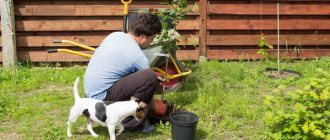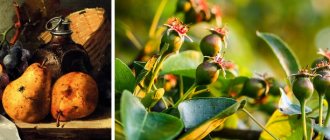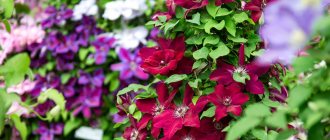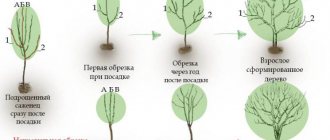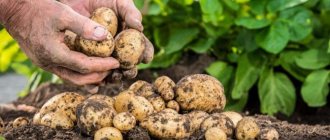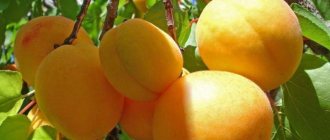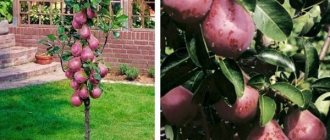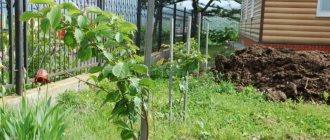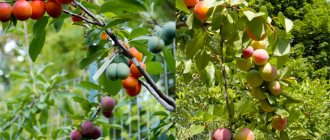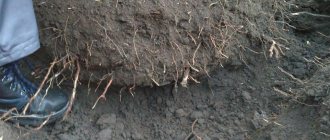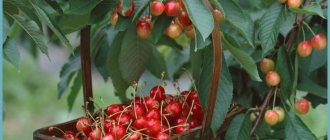When to plant apple and pear trees
In autumn, it is best to plant fruit seedlings from the moment the leaves fall from the trees until frost appears. This is approximately the end of September and until the twentieth of October. It is advisable that the planted trees have about twenty days before the cold weather. During this time they will have time to take root. It is recommended that the temperature does not fall below +4.
Apple tree seedlings
If fruit tree seedlings have a closed root system, then the planting time is extended. They can be planted in November, approximately until the middle of November. When purchasing planting material with leaves, you must tear them off after planting. Leaves divert the plant's energy to support their life support and contribute to its drying out.
Apple tree planting dates by region
Having decided on the autumn planting of an apple tree, the gardener is guided by local climatic conditions. The closer to the south, the later trees are planted.
Eastern Siberia , where snow falls regularly from mid-October, the planting season ends in the second half of September.
The Urals and Western Siberia - in the north in the second half of August - September, in the south until mid-October.
Central regions (Moscow region, Leningrad region) - second half of September to mid-October.
Middle zone, Volga region - until the end of October.
The southern regions are planted from mid-October for a month and a half.
General recommendations are adjusted by the characteristics of the current season. The warmer the autumn, the later the time for planting apple trees in the fall comes.
Winter storage of fruit seedlings
Autumn weather can bring surprises and be unpredictable. If the successful period for planting never came or was missed, fruit tree seedlings should be buried . To do this, make a trench on a site where groundwater does not stagnate. The wall on the south side is flat; on the north side, the side of the trench can be steep.
Storing seedlings in winter
Plants have their crown facing south, the roots are sprinkled with sand and loose soil. Water it so that the air pockets disappear and cover it with soil again. Tree roots should not touch each other. By winter, with the onset of cold weather, fruit seedlings are completely covered with soil, only the tips of the branches peek out.
Bare-rooted trees will be stored in the cellar until spring.
Now let's take a closer look at how fruit tree seedlings are planted.
Intensive apple varieties
These varieties are distinguished by early fruiting, abundant and regular harvests. For example, while most varieties begin to bear fruit in the 5-7th year, intensive varieties begin to bear fruit already in the first 3 years after planting. Choose Folk, Winner, Student, Melba, Lobo, Wellsie, Dessert Isaeva, Mekanis, Young Naturalist, Orlik, Zhigulevskoe, Northern Synap, Antey, Darunak, Imant, Memory Kovalenko, Pospeh.
The so-called spur varieties are famous for their super intensity. Low-growing trees with shortened internodes are completely covered with “fruiting points” - ringlets. Most of them come from American varieties and are grown mainly in our south: Delicious, Golden Delicious, Mekintosh.
Planting apple tree seedlings
Before planting an apple orchard, it is necessary to mark the site and determine the location of the excavations. The distance between trees should be taken based on the varieties of apple trees. If the apple trees are vigorous varieties, then the planting scheme is: the distance between plants is 4 meters, between rows is 6 meters. Low-growing varieties can be planted at a distance of three meters and maintain 5 meters between rows.
If apple trees are planted in the fall, the soil is prepared two months in advance.
For this period:
- the soil is dug up, removing weed roots,
- apply complex fertilizers,
- dig up the soil again,
- 1.5 months before planting trees, excavations are made, drainage is arranged, and fertilizer is applied.
What to do if the apple tree does not bear fruit?
An apple tree, with the exception of intensive varieties, usually begins to bear fruit in the 5-7th year after planting. But sometimes the onset of fruiting is delayed. Why? There may be several reasons. First, we check whether we deepened the neck of the tree too much when planting. If this is the case, the apple tree will have to be raised. The second possible reason is vertical growth of branches. Fruit shoots of an apple tree are formed only on horizontal branches. Therefore, using weights or guy ropes, we give them a horizontal position.
There is another old “grandfather’s” way to make an apple tree bear fruit. We drive several rusty nails into the trunk of the apple tree or simply bury various metal objects in the circle around the trunk.
With this we replenish the missing supply of iron for fruiting. Try it! Don't trust your grandfather's advice? Then do not forget to spray the apple tree 2-3 times per season with a 0.1% solution of iron sulfate (1 teaspoon of sulfate per 10 liters of water).
Planting pears
Pears and apple trees are very similar in terms of cultivation technology. Plants should be planted, determining the distance between trees depending on the size of the pear in adulthood. The distance between plants is no less than the sum of the heights (the estimated height of an adult pear or apple tree) of neighboring trees. This distance is comfortable because the plants will not block each other’s light, it is possible to ventilate them, and it is convenient to care for the tree crowns.
Soil preparation is the same as for apple trees. If the planting hole is prepared on cultivated land, then it should be of such size as to accommodate the roots. Usually, a recess of 0.8 x 0.8 meters and a depth of approximately 0.9 meters is made for apple and pear trees. When the soil is taken out, the top fertile layer is discarded on one side, and the one below is discarded in another place so that they do not mix.
Choosing a site for planting pears
The pear is a sun-loving plant, so you need to choose open areas of the garden for planting; it is advisable to plant it on a hill, avoiding places with strong wind currents.
Also, when choosing a location, it is necessary to take into account the depth of groundwater. Since the pear has a very powerful root system, which in an adult tree can reach up to three meters in depth and width. If the root system reaches groundwater, the roots will rot and the plant will quickly wither.
An important factor when choosing a planting site is the proximity to other pear varieties. This is necessary for natural pollination. If there are no such trees in the neighborhood. Then it is necessary to plant at least two pear seedlings of different varieties. Otherwise, you risk seeing beautiful blooms in the spring and being left without a harvest in the fall.
In the photo: Choosing a site for planting a pear
Soil requirements for planting pears
Unlike other fruit trees, the pear is not so demanding on the soil. However, it has long been noticed that the pear feels better on slightly acidic sandy loam soil. On such soil, the pear is less susceptible to scab, unlike neutral soils.
At the same time, the pear does not take root well on soil with a high alkali content. Due to a lack of microelements, the tree suffers from chlorosis and loses frost resistance.
In order to determine the composition of the soil, use the table below and take a closer look at the plants growing on it:
| Soil Ph | Plants |
| Highly alkaline soil | field bindweed, cress, quinoa |
| Neutral soil | nettle, clover |
| Acidic soil | horse sorrel, moss, woodlice, plantain and horsetail |
| Slightly acidic soil | beet tops have red veins on green leaves |
Table: Determination of soil composition by plants
To stabilize soil characteristics it is necessary:
- High acidity is reduced with slaked lime or dolomite flour;
- Slightly alkaline soil can be enriched by adding peat, oak leaf compost or rotted manure;
- To increase acidity with a high alkali content, deep digging of the soil is carried out with the addition of gypsum, granulated sulfur or potassium sulfate.
Planting scheme
When laying out a garden and planting trees, you first need to take into account the needs of the tree, maintaining a distance between seedlings so that the crown of a neighboring tree does not interfere with the development of a young pear. If the planting is thickened, due to lack of lighting the trees will grow to the heights, like in a forest, and then harvesting will be difficult.
Therefore, the distance between trees should be at least 5 meters, and row spacing 7 meters. Columnar pears require much less space, so the distance can be reduced to three meters between seedlings and up to five meters between rows.
In the photo: Pear planting scheme
Preparing the planting hole
Preparing the planting hole is one of the most critical moments, and this applies not only to pears, but also to any fruit trees. In order for the plants to feel comfortable and develop well, the pit must be prepared in advance.
If you plan to plant seedlings in the spring, then it is advisable to prepare the hole in the fall. That is, the pit must be prepared in advance. At worst, a month and a half before landing.
Why is this being done? The fact is that during this time the earth has time to settle and fill the voids that can prevent the root system from developing. Also, mineral fertilizers and mixtures added to the soil have time to burn out and mix with the soil, which significantly reduces the likelihood of burns to the root system of the seedling.
Scheme: Preparing the planting hole and applying fertilizers
Digging a hole
Having decided on the place for planting the pear and the timing, we proceed to constructing a planting hole. Its dimensions are determined by the root system of the seedling. The width should be at least twice as wide and the depth three. Typically the size is: 70 centimeters wide and a meter deep.
Many may ask, why such depth? The fact is that the root of a pear can go down to a depth of three meters and at the rooting stage it will be difficult for the seedling to break through the compacted layers of soil.
Having marked the edges of the future hole with a shovel, we remove the fertile layer, discarding it separately from the rest of the soil. Later we mix the fertile soil with fertilizers, peat and compost. We pour the saturated mixture at the level of the root system of the seedling. This layer will allow the seedling to take root more easily and immediately begin to grow.
Having dug a hole, we begin to fill it. At the very bottom of the pit we arrange drainage from coarse gravel, expanded clay or broken brick, in a layer of 10 centimeters. It is worth immediately noting that drainage is only needed if the groundwater lies very high, that is, less than 2-3 meters.
This can be determined by the puddles after a good rainfall. If water is absorbed into the ground quickly, then drainage is not needed, but if puddles remain for several days or weeks, then this is a sure sign of high groundwater.
Next, we sprinkle the drainage layer with plain soil, tamp it and thoroughly pour it with water, this is done in order to fill the air voids, since the root getting into such voids begins to rot and the tree begins to wither.
At the next stage, we pour rusty metal shavings or small metal parts, nails, bolts, washers into the bottom of the hole. This is done to saturate the earth with iron. Next, the layer is again covered with earth, compacted and thoroughly spilled with water.
If the soil is heavy or clayey, you need to add river sand or rotted sawdust, thereby making the soil more loose and breathable. If the soil is too loose, then instead of drainage it is necessary to put a layer of compacted clay to retain moisture.
The next last layer is laid with previously prepared fertile soil, tamped again and spilled with water. That's it, the pit is ready. After thorough watering, you can mulch it with sawdust or leaves and leave the hole for a while. Before planting the pear, the hole must be loosened.
Preparation of seedlings
Seedlings should be carefully examined. Trim broken roots and branches. If the root is overdried, soak it in water, you can add a drug against root pests.
The roots of fruit seedlings are fresh, not dry - they do not require soaking, but it is very good to dip them in mash. How to make it: mix a kilogram of clay and a kilogram of chernozem, dilute with three liters of water, you can add a bag of root and a pest control drug, for example, Aktaru.
Planting seedlings
Planting fruit tree seedlings with your own hands - tips
Useful recommendations for gardeners:
How to plant an apple tree?
Early-fruiting varieties of some apple trees can bloom in the first spring. But they are not yet developed enough to form a full-fledged harvest in the fall. Therefore, for good survival, the buds are cut off before they bloom. In the second year (provided that the plant develops without problems), a couple of dozen flowers are left on the tree.
Among the most easily adaptable varieties of apple trees are: “Grushovka Moskovskaya”, “Antonovka ordinary”, “Summer striped”, “Brusnichnoe”, “Dessert Isaeva”, “Gift to Grafsky”, “Cinnamon new”. Good varieties: “China Kerr”, “Arkadik”, “Ovalnoe”, “Lungwort” and “Candy”.
How to plant a pear?
Most types of pears known to summer residents do not have special requirements for exposure and soil composition. But pear trees take root and grow better in humus-rich, loose soils and well-lit areas. Young plants do not tolerate drought. In the first years they need to be watered abundantly and often. Pears begin to bear fruit at the age of 3-8 years.
As a result of hybridization of species, specialists in the field of breeding have developed a huge number of interesting varieties. Among the popular ones: “Pear Favorite Klappa”, “Pear Lada”, “Pear Nectar”, “Cathedral”, “Allegro”, “Dibrovskaya”, “Beauty Chernenko”.
How to plant cherries?
The fruiting of cherries largely depends on the planting location on the site. Wrong choice leads to poor growth and poor yields. The cherry root system, located close to the surface, is sensitive to drought. Therefore, loosening after watering is done extremely carefully.
In the gardens of our country, local, winter-hardy varieties predominate: “Octava”, “Bagryannaya”, “Kentskaya”, “Shubinka”, “Rossoshanskaya Chernaya”, “Rusinka”, “Polevka”, “Molodezhnaya”, “Malinovka”, “Prima” , “Turgenevka”, “Lyubskaya”, “Zhukovskaya”, “Generous”.
Planting a tree with your own hands - video
General landing rules
Fruit trees and shrubs should be planted at the same depth as they grew before planting in the nursery. It is very important. A plant planted deeper grows poorly and bears fruit late.
When planting trees, you need to make sure that their root collar is at ground level. The root collar is the name given to the place of transition from the root to the trunk, so as not to be confused with the place where the grafting took place. Experienced gardeners advise that when planting deeply, it is better to replant the tree immediately than to leave it buried.
A mound is poured into the planting hole, after which a seedling is placed on it, the roots are spread along the slopes of the mound. When planting seedlings, it is important to remember that the roots are sprinkled with fertile soil of the upper layer, and the soil of the lower layer is added on top. You can fill the entire planting hole with prepared fertile soil.
After planting, fruit trees and shrubs are watered abundantly. This is necessary so that the roots are more closely connected to the ground. They provide support and tie up the seedlings.
Advantages and disadvantages of planting an apple tree in the fall
Planting work is always in early spring or autumn. For decades, novices and experts have been arguing about when it is better to plant. Disputes out of nowhere stop when everyone weighs the pros and cons of planting dates for themselves.
Advantages
What attracts gardeners to rooting trees before winter? After all, these are the timings that have traditionally been considered optimal.
The autumn planting period has a number of significant advantages:
- at the end of the season, nurseries have the widest selection of healthy seedlings. And in the spring, customers are offered planting material that has overwintered in containers, left over from the autumn sale;
- a seedling in a dormant state will take root faster: it does not need to waste energy growing foliage or trying to bloom;
- for summer residents from the southern regions with early hot springs and low-rainy, hot summers, it is more difficult for seedlings to emerge that need to take root in such conditions;
- In the spring, an apple tree planted before winter immediately begins a new growing season.
Autumn planting is preferred by residents of the south, Central Russia, Central Russia, and Western Siberia. The harsher the climate, the more often planting is postponed to spring. Although even in the risky farming zone, they try to get the timing right so that it is not too late to plant an apple tree in the fall, but also not to rush into planting.
Flaws
The disadvantages of autumn work with seedlings are associated with risks. It is impossible to predict what the weather will be like, how long the warmth will last, or how soon the frost will arrive. The weather forecasters are wrong. Gardeners take risks.
Problems of autumn planting:
- plant too early - stimulate vegetative processes instead of dormancy;
- plant too late - the seedling will not have time to grow roots, which means it will not survive the winter;
- sudden warming or cooling are factors that reduce the chances of rapid rooting and hibernation;
- young trees must be covered for the first winter;
- if mistakes were made during planting, this will become clear only by mid-summer, when it is better not to touch the rooted tree;
- During the winter and with melt water in the spring, the insufficiently compacted soil in the planting hole sags, pulling the root collar. When planting in spring, this is corrected immediately, until the apple tree has acquired new roots.
But the last two problems are the result of errors in preparation and landing. If everything is done correctly right away, these risks do not threaten the young tree.
Preparing for winter
Autumn tree planting involves activities to prepare the plants for winter. Before the cold weather, the seedlings are hilled up . The trunks of fruit trees are tied with branches of pine needles to prevent freezing and damage by hares. You can prepare a seedling for winter using handy materials: wrap the trunk with corrugated cardboard, plastic mesh, the main thing is that the material allows air to pass through.
The time frame for preparing young trees for winter begins in September . The trunk circle is shed with water and mulched so that the roots and root collar do not freeze. It is better to plant winter-hardy varieties of apple and pear trees in the fall; it is better to dig up the remaining seedlings of fruit trees for planting in the spring.
How to plant a pear tree correctly - a step-by-step guide
Before you plant a pear, you need to choose a place suitable for this heat-loving crop. The main requirements for cultivation are good sun exposure from all sides and the absence of through cold winds, so the pear is planted on the south side of the site.
Before digging a planting hole, it is necessary to consider one more important factor - there should be no tall trees nearby that will subsequently shade the pear, compete for nutrients and come into contact with its crown.
Pit preparation
Taking into account the root system of the pear seedling, which during the first years will consume all the necessary nutrients from the mixture placed in the hole during planting, its dimensions will be 60 cm in depth and 1 m in diameter. The steep walls of the pit will ensure the necessary shrinkage of the earth after planting. When planting, you will need the top layer of soil discarded when digging the planting site, and the soil removed from the lower layers will not be useful.
The pit is filled with a nutrient mixture. To prepare it, you need to add mineral fertilizers to 6 liters of compost: 30 g of potassium salt and 60 g of superphosphate. Under no circumstances should nitrogen-containing fertilizers be added to the planting hole. In order for a special microclimate to form inside the substrate and the chemicals not to burn the young pear roots, the planting pit is prepared in advance - in late spring - early summer.
Landing
Planting a pear seedling takes place in stages. Below are detailed instructions for planting a fruit tree at your summer cottage.
- You need to form a small mound inside the hole, after which you pour it generously and wait for the water to settle.
- The seedling must be prepared for planting: if it has an open root system and it has dried out a little, the pear is placed in water for 12...24 hours.
- To install the seedling in the planting hole, you may need the help of another person. Then one will hold the pear strictly vertically by the trunk, and the second will place the root system in the ground.
- The roots of the seedling are straightened with extreme care and spread along the slopes of the mound in the hole. You can start burying a seedling only after making sure that its root collar will be located 5 cm above the ground surface.
- After installing the pear, its roots begin to be buried, carefully but quite tightly, compacting the soil so that no air voids remain.
- After planting, the trunk of the tree is tied with a soft cloth to a peg.
- It is necessary to make a hole around the pear so that when watering the water does not flow down the sides, but goes directly to the roots. Post-planting watering should be plentiful - 2...3 buckets of water are poured onto one young seedling.
- The planting of the pear is completed by mulching the tree trunk circle. Sawdust and peat can be used as mulch. Mulching prevents premature evaporation of moisture from the soil.
Read also: Meat in white sauce recipe with photos
There are two diametrically opposed opinions regarding pruning pear seedlings during planting.
- Some argue that healing the wound at the cut site takes a lot of effort from the plant, which is intended to prepare for winter.
- Others suggest that pruning annual pear seedlings stimulates root growth.
After weighing all the pros and cons, each gardener determines for himself whether he needs to shorten the top of the seedling or not.
Proper autumn planting of a pear will ensure its good survival rate, rapid development and high yields in a few years.
If groundwater is nearby
A particular problem when planting pears can be the close location of groundwater to the surface. In such areas, it will not be possible to grow a crop without the use of special agrotechnical techniques.
- In order to lower the groundwater level, you can organize a drainage ditch, drain the area, or dig a small lake in the lowest area of the dacha. The method of artificially lowering the water level is very labor-intensive and expensive.
- You can plant a pear on a hill. To do this, a hill is formed from imported soil. You can put slate at the bottom of the hole, which will prevent the root system from deepening into the soil and force it to branch horizontally.
The main sign that the root system has reached groundwater is the drying of the tops of the pear.
